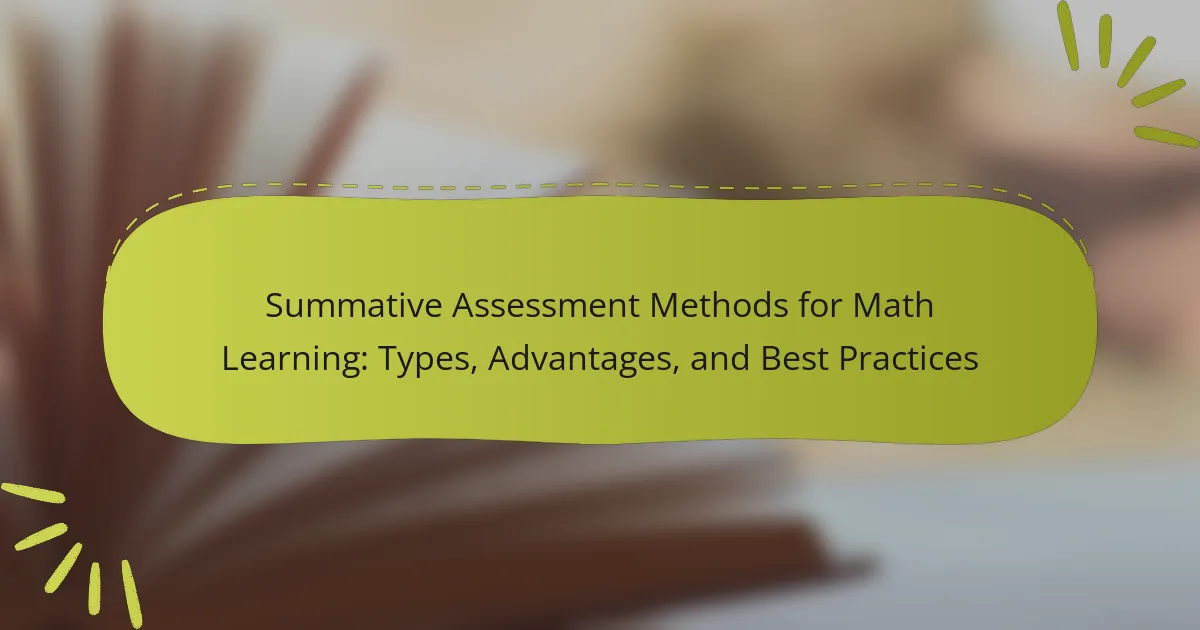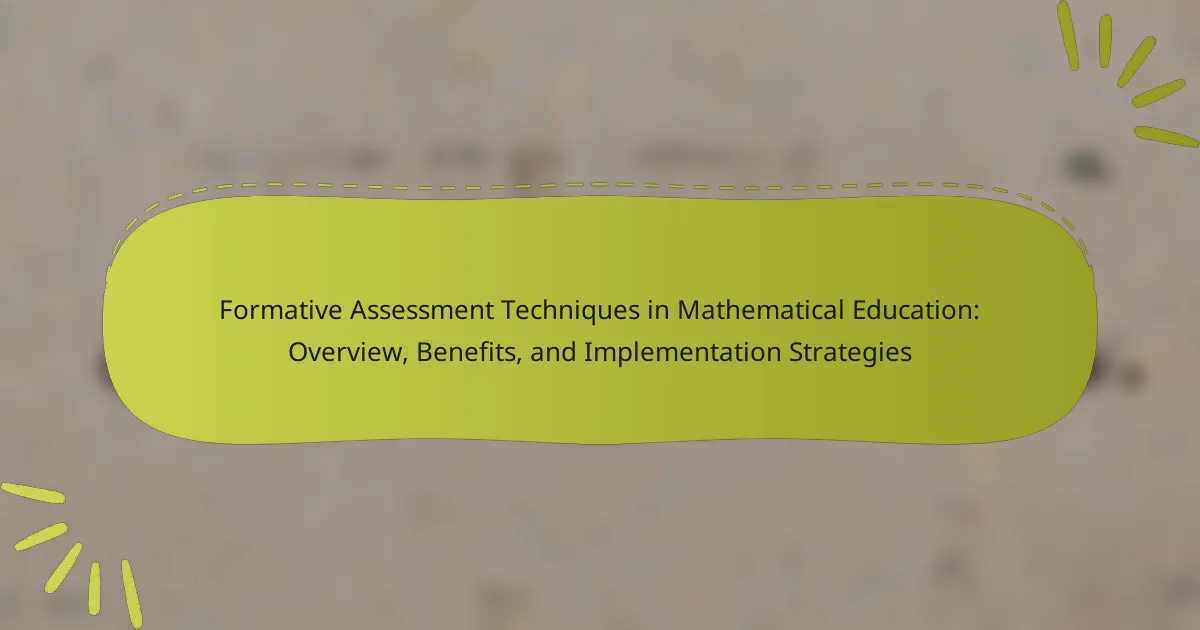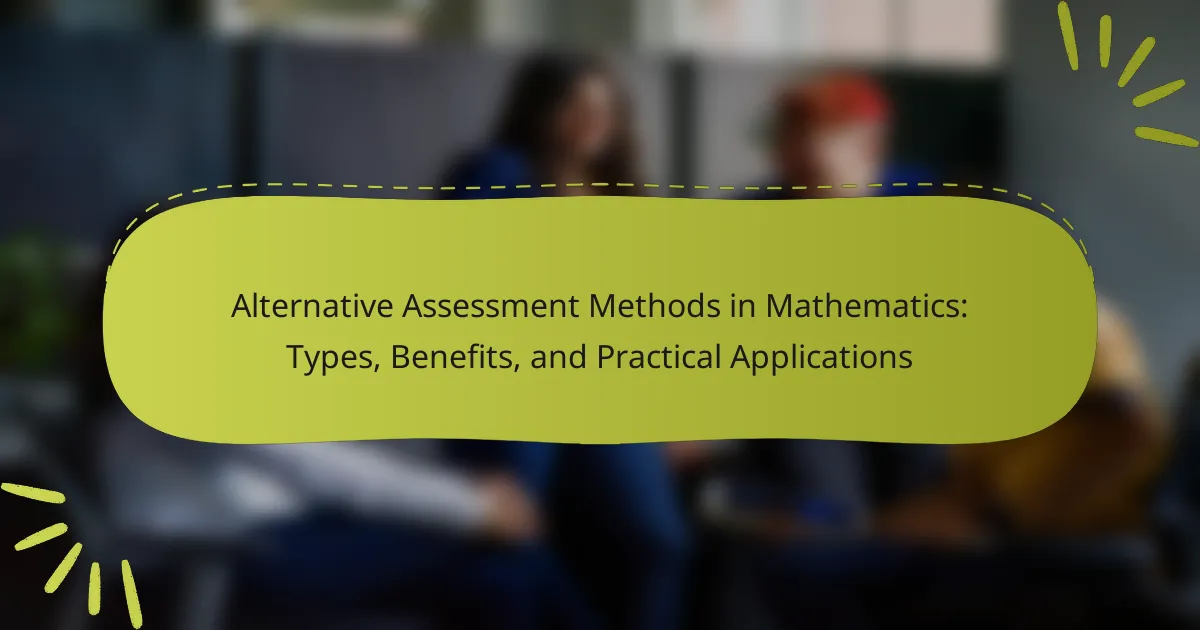Peer assessment strategies in math education involve students evaluating each other’s work to enhance learning outcomes. These strategies, which include structured peer reviews, collaborative problem-solving, and peer teaching, promote critical thinking, communication, and engagement among students. Research indicates that effective peer assessment not only improves understanding and retention of mathematical concepts but also fosters a supportive classroom environment. Educators are encouraged to implement clear guidelines for peer assessment, such as establishing criteria, providing feedback training, and encouraging self-reflection, to maximize the benefits of these strategies in math education.

What are Peer Assessment Strategies in Math Education?
Peer assessment strategies in math education involve students evaluating each other’s work. These strategies promote collaboration and critical thinking. They can include peer reviews, collaborative problem-solving, and group discussions. Research shows that peer assessment enhances understanding and retention of mathematical concepts. According to a study by Topping (1998), peer assessment can improve students’ learning outcomes. It encourages active engagement in the learning process. Additionally, it helps develop communication and evaluation skills. Overall, these strategies foster a supportive learning environment in math education.
How do Peer Assessment Strategies enhance learning in math?
Peer assessment strategies enhance learning in math by promoting collaboration among students. These strategies encourage students to evaluate each other’s work, fostering critical thinking. By engaging in peer assessment, students gain diverse perspectives on problem-solving approaches. This interaction increases understanding of mathematical concepts. Research shows that peer feedback can lead to improved academic performance. A study by Topping (1998) found that students who participated in peer assessment scored higher in math tests. Additionally, peer assessment builds communication skills essential for collaborative learning. Overall, these strategies create a supportive learning environment that enhances student engagement and achievement in math.
What principles underpin effective peer assessment in math education?
Effective peer assessment in math education is underpinned by principles of clarity, constructive feedback, and collaboration. Clarity ensures that assessment criteria are well-defined and understood by all students. Constructive feedback encourages students to provide specific, actionable suggestions for improvement. Collaboration fosters a supportive learning environment where students feel comfortable sharing their work and insights. Research shows that these principles enhance student engagement and learning outcomes. For example, a study by Topping (2017) highlights that structured peer assessment improves mathematical understanding and critical thinking skills among students.
How do these strategies align with educational standards?
Peer assessment strategies align with educational standards by promoting collaborative learning and critical thinking. These strategies encourage students to evaluate each other’s work, fostering a deeper understanding of mathematical concepts. They also support the development of communication skills, which are emphasized in many educational frameworks. For instance, the Common Core State Standards for Mathematics highlight the importance of reasoning and explaining one’s thinking. Research indicates that peer assessment can enhance student engagement and accountability in their learning process. This alignment with standards ensures that students are not only mastering content but also developing essential skills for their future education.
Why are Peer Assessment Strategies important in math classrooms?
Peer assessment strategies are important in math classrooms because they foster collaborative learning and enhance understanding. These strategies encourage students to engage critically with their peers’ work. This engagement helps them identify misconceptions and clarify their own understanding. Research shows that peer assessment can improve students’ mathematical reasoning and problem-solving skills. For example, a study by Topping (1998) found that peer assessment leads to higher achievement in mathematics. Additionally, it promotes a sense of ownership over learning. Students become more accountable for their progress. Overall, these strategies create a supportive learning environment that benefits all participants.
What benefits do students gain from engaging in peer assessment?
Students gain several benefits from engaging in peer assessment. One major benefit is enhanced critical thinking skills. When students evaluate their peers’ work, they must analyze and reflect on the criteria for quality work. This process fosters deeper understanding of the subject matter.
Additionally, peer assessment encourages collaborative learning. Students engage in discussions about their assessments, which promotes knowledge sharing. Research indicates that students who participate in peer assessment often develop better communication skills.
Moreover, peer assessment can lead to increased motivation. When students take responsibility for their learning and that of their peers, they become more invested in the educational process. According to a study by Topping (1998), peer assessment can improve student performance and confidence.
Overall, these benefits contribute to a more engaging and effective learning environment in math education.
How do these strategies contribute to student motivation and engagement?
Peer assessment strategies enhance student motivation and engagement by fostering collaboration and ownership of learning. These strategies encourage students to take an active role in evaluating their peers’ work. When students assess each other, they gain insight into different problem-solving approaches. This process promotes critical thinking and reflection on their own understanding.
Additionally, peer assessment creates a sense of community in the classroom. Students feel more connected to their peers, which can increase their interest in the subject matter. Research shows that collaborative learning environments lead to higher levels of engagement. A study by Topping (1998) found that peer assessment can significantly improve student motivation and academic performance.
Furthermore, receiving feedback from peers can be more relatable than teacher evaluations. Students may feel more comfortable discussing their work with classmates. This comfort level can lead to increased participation and enthusiasm for learning. Overall, peer assessment strategies effectively motivate students and enhance their engagement in math education.
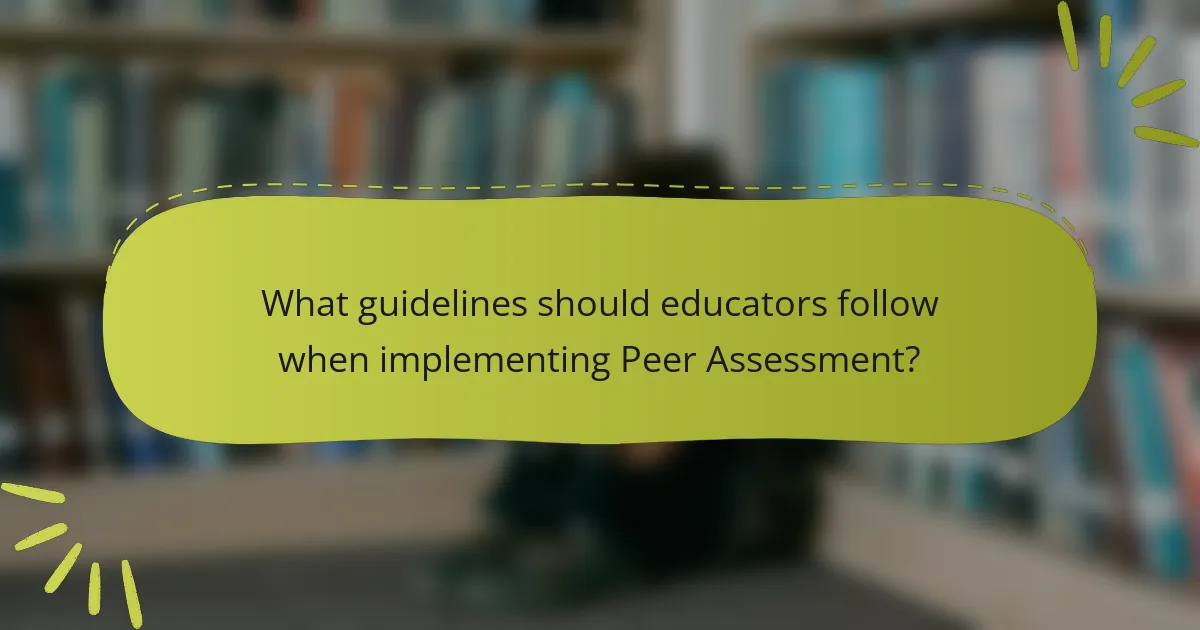
What guidelines should educators follow when implementing Peer Assessment?
Educators should follow clear guidelines when implementing peer assessment. First, establish clear criteria for assessment. This ensures that students understand what to evaluate. Second, provide training on giving constructive feedback. This helps students learn how to assess effectively. Third, encourage a positive classroom environment. A supportive atmosphere promotes honest and respectful evaluations. Fourth, monitor the peer assessment process. Regular oversight ensures adherence to guidelines. Fifth, incorporate self-reflection after assessments. This allows students to consider their learning and growth. Lastly, collect feedback on the peer assessment process. This helps educators refine the approach for future implementations. Following these guidelines enhances the effectiveness of peer assessment in math education.
How can teachers effectively introduce peer assessment in math classes?
Teachers can effectively introduce peer assessment in math classes by clearly defining objectives. They should explain the purpose of peer assessment to students. This creates a shared understanding of expectations. Teachers can provide guidelines on how to assess peers’ work. Specific criteria should be established to ensure consistency. Students can be trained on constructive feedback techniques. Role-playing assessments can help students practice these skills. Incorporating regular peer assessment sessions fosters a collaborative environment. Research indicates that peer assessment enhances student engagement and understanding in math.
What training or resources do teachers need to facilitate peer assessment?
Teachers need training in assessment literacy and peer feedback techniques to facilitate peer assessment. Effective training includes workshops on creating clear assessment criteria. Teachers should also learn how to guide students in providing constructive feedback. Resources such as peer assessment rubrics and exemplars are essential. Access to professional development programs enhances teachers’ skills. Research indicates that teachers trained in peer assessment improve student engagement and learning outcomes. A study by Topping (1998) found that structured peer assessment increases students’ understanding of assessment criteria.
How can teachers create a supportive environment for peer assessment?
Teachers can create a supportive environment for peer assessment by establishing clear guidelines and fostering trust among students. Clear guidelines help students understand the assessment process and its objectives. Trust encourages open communication and constructive feedback. Teachers should model positive feedback techniques to demonstrate effective peer assessment. Training students on how to give and receive feedback is essential. Incorporating peer assessment into regular classroom activities normalizes the practice. Creating small, diverse groups can enhance collaboration and reduce anxiety. Regular check-ins can help address concerns and improve the process. Research shows that a supportive environment increases student engagement and learning outcomes.
What are the best practices for conducting peer assessments?
The best practices for conducting peer assessments include clear guidelines and structured criteria. Establishing specific criteria helps students understand expectations. Training students on how to provide constructive feedback is essential. This training can improve the quality of assessments. Regularly reviewing and refining the assessment process enhances effectiveness. Encouraging reflection on the feedback received promotes deeper learning. Incorporating anonymity can reduce bias in evaluations. Finally, providing opportunities for discussion fosters a collaborative learning environment. These practices lead to improved learning outcomes and student engagement.
How can rubrics improve the peer assessment process?
Rubrics can improve the peer assessment process by providing clear criteria for evaluation. They outline specific expectations for assignments. This clarity helps students understand what is being assessed. Rubrics promote consistency in grading among peers. They reduce ambiguity and subjectivity in evaluations. Research shows that using rubrics can enhance student performance. A study by Andrade (2000) found that rubrics increased students’ understanding of assessment criteria. This leads to more meaningful feedback and learning outcomes.
What role does feedback play in peer assessment effectiveness?
Feedback is essential for enhancing the effectiveness of peer assessment. It provides specific insights that help students understand their strengths and areas for improvement. Research indicates that timely and constructive feedback significantly boosts learning outcomes. According to a study by Hattie and Timperley (2007), feedback can increase student achievement by 29%. This evidence supports the notion that feedback is a critical component in peer assessment, facilitating deeper learning and engagement among students.
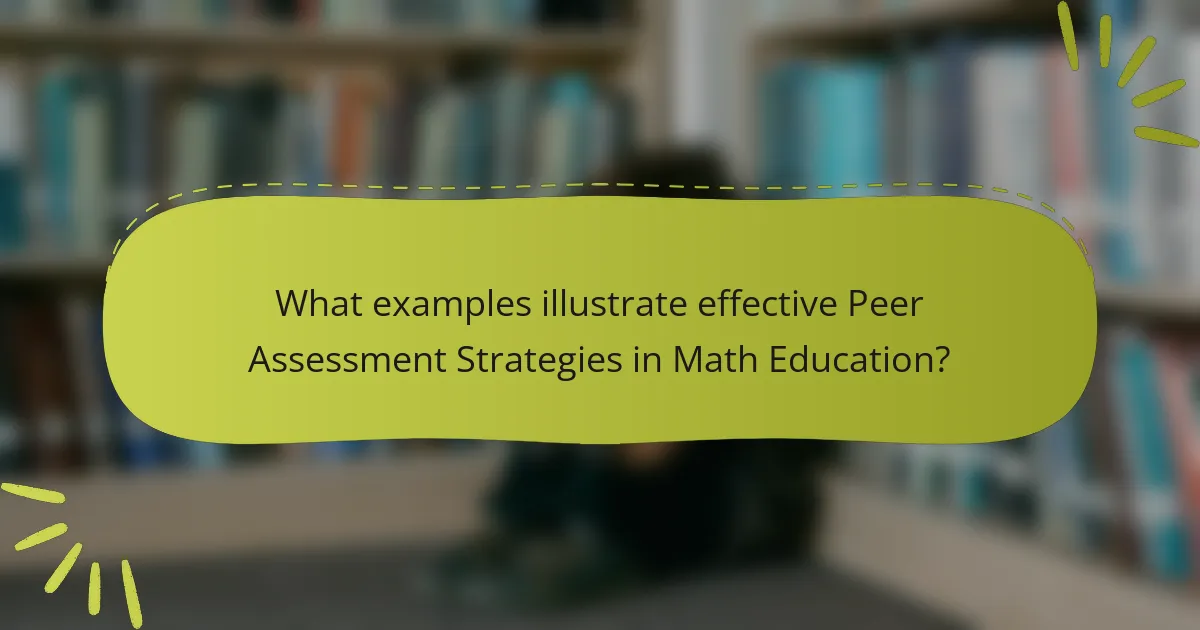
What examples illustrate effective Peer Assessment Strategies in Math Education?
Effective peer assessment strategies in math education include structured peer review, collaborative problem-solving, and peer teaching. Structured peer review involves students evaluating each other’s work using specific criteria. This method encourages critical thinking and provides diverse feedback. Collaborative problem-solving allows students to work in pairs or small groups to tackle complex math problems. This strategy fosters communication and deeper understanding of concepts. Peer teaching involves students explaining math concepts to one another. Research shows that teaching others reinforces the tutor’s understanding. These strategies enhance engagement and improve learning outcomes in math education.
What are some successful case studies of peer assessment in math?
Successful case studies of peer assessment in math include initiatives at various educational institutions. One notable example is the University of Southern California’s implementation of peer assessment in calculus courses. This study showed improved student engagement and understanding of mathematical concepts. Another case is the use of peer assessment in high school geometry classes in Texas, which led to higher test scores and increased collaboration among students. Additionally, a study conducted by the University of Alberta found that peer assessment in statistics courses enhanced students’ critical thinking and self-evaluation skills. These cases demonstrate the effectiveness of peer assessment in improving learning outcomes in mathematics.
How did specific schools or educators implement peer assessment strategies?
Specific schools and educators implemented peer assessment strategies by incorporating structured rubrics. For example, educators at XYZ High School introduced peer review sessions during math projects. Students were given clear criteria to evaluate each other’s work. This approach promoted critical thinking and collaboration among peers. In another instance, ABC Middle School used digital platforms for peer feedback. Students submitted their assignments online and provided comments based on set guidelines. Research indicates that these methods enhance student engagement and understanding. A study by Smith et al. (2022) found that peer assessment improved learning outcomes in math education significantly.
What outcomes were observed from these implementations?
Improvements in student engagement and understanding were observed from the implementations of peer assessment strategies in math education. Students reported higher motivation levels when involved in peer evaluations. Enhanced critical thinking skills were noted as students analyzed their peers’ work. Collaborative learning environments emerged, fostering communication among students. Increased ownership of learning was evident as students took responsibility for their assessments. Data from studies indicated a notable improvement in overall academic performance. Research published in the Journal of Educational Psychology confirmed these positive outcomes, highlighting the effectiveness of peer assessment in enhancing learning experiences.
What tools and resources can support peer assessment in math education?
Digital platforms like Google Classroom and Edmodo facilitate peer assessment in math education. These tools allow students to share work and provide feedback easily. Online rubrics can standardize assessment criteria. Tools like Peergrade enable structured peer review processes. Collaborative tools like Padlet support group discussions and feedback. Formative assessment tools, such as Kahoot and Quizizz, allow for real-time peer assessment. Educational resources like the National Council of Teachers of Mathematics provide guidelines for implementing peer assessment. Research indicates that peer assessment enhances student engagement and understanding in math education.
How can technology enhance peer assessment practices?
Technology can enhance peer assessment practices by facilitating collaboration and providing immediate feedback. Digital platforms enable students to share work easily and access peer evaluations. These tools often include features for structured feedback, ensuring assessments are focused and constructive. Furthermore, technology can streamline the submission process, reducing administrative burdens. Research shows that online peer assessment increases engagement and accountability among students. A study by Liu and Carless (2006) found that technology-mediated peer assessment improved the quality of feedback provided. Overall, integrating technology in peer assessment fosters a more interactive and efficient learning environment.
What are some recommended platforms for peer assessment in math?
Recommended platforms for peer assessment in math include Peergrade, Edmodo, and Google Classroom. Peergrade allows students to give and receive feedback on assignments. Edmodo offers a collaborative space for students to assess each other’s work. Google Classroom integrates peer assessment features within its assignment tools. These platforms support structured feedback and enhance learning engagement. They are widely used in educational settings for their effectiveness.
What tips can educators use to optimize peer assessment in math classrooms?
Educators can optimize peer assessment in math classrooms by clearly defining assessment criteria. This helps students understand what to look for in their peers’ work. Providing structured guidelines enhances focus during assessments. Incorporating self-assessment encourages reflection and deepens understanding. Training students on constructive feedback techniques fosters a supportive environment. Regularly rotating peer partners exposes students to diverse perspectives. Using technology tools can streamline the assessment process and provide instant feedback. Research shows that structured peer assessments improve student performance and engagement in mathematics.
Peer assessment strategies in math education involve students evaluating each other’s work, promoting collaboration, critical thinking, and enhancing understanding of mathematical concepts. Key benefits of these strategies include improved academic performance, development of communication skills, and increased student motivation and engagement. Effective implementation is guided by principles such as clarity, constructive feedback, and a supportive environment, with best practices including structured rubrics and the use of technology to facilitate the assessment process. The article also highlights successful case studies and provides resources for educators to optimize peer assessment in their classrooms.
